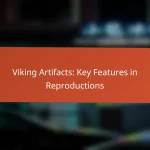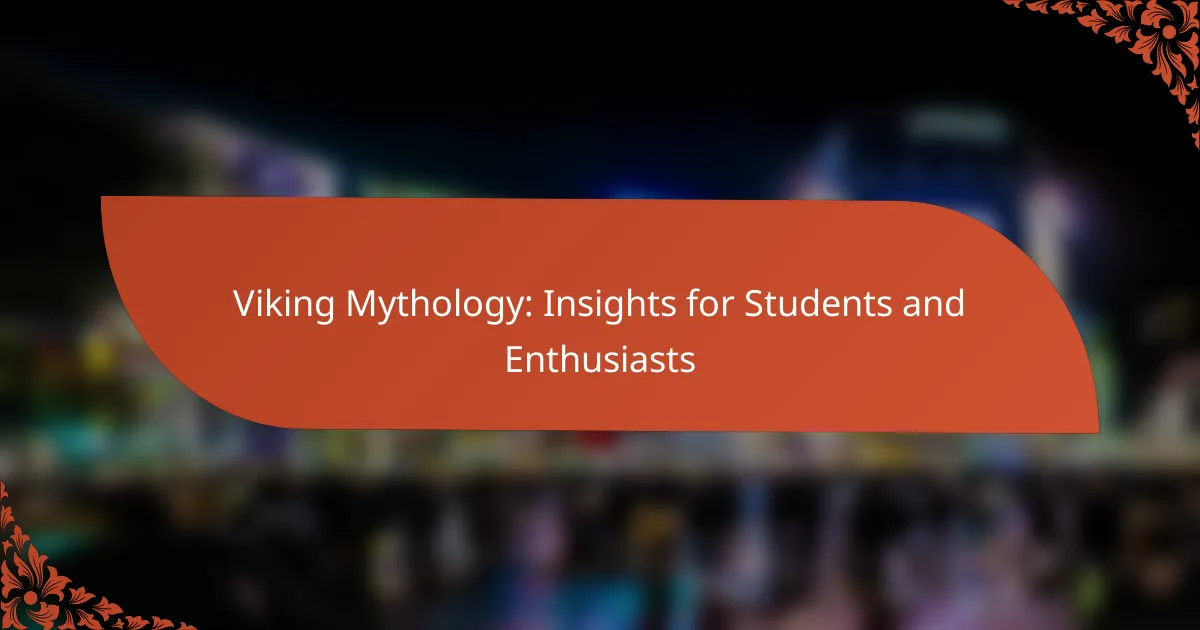In Viking mythology, women were pivotal figures, often portrayed as powerful warriors, spiritual leaders, and revered deities. Their influence extended beyond the mortal realm, shaping folklore and preserving cultural narratives through storytelling. Key goddesses like Freyja, Frigg, and Skadi exemplified the diverse roles women played, impacting various aspects of life, from love to warfare, within Viking society.
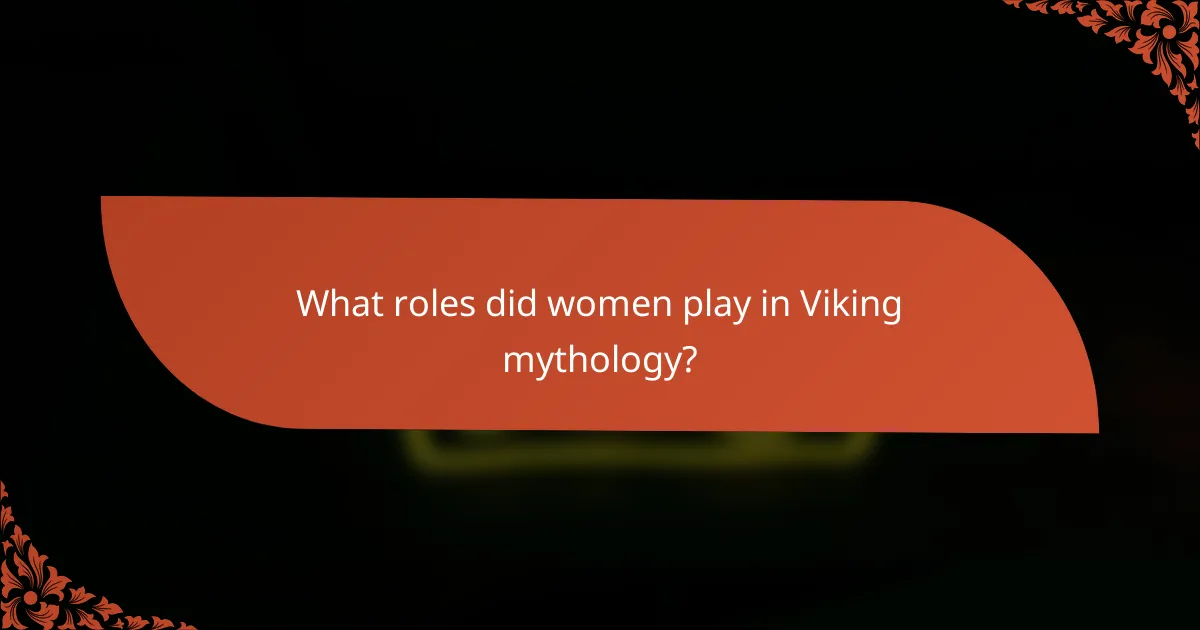
What roles did women play in Viking mythology?
Women in Viking mythology held significant roles, often depicted as powerful figures influencing both the mortal and divine realms. They were not only warriors but also spiritual leaders and revered deities, showcasing a complex societal structure where female figures were integral to the mythology.
Shieldmaidens as warriors
Shieldmaidens were women who chose to fight alongside men in battles, embodying the warrior spirit of the Vikings. Historical sagas suggest that these women trained in combat and were skilled in the use of weapons, challenging traditional gender roles of their time.
While the existence of shieldmaidens is debated among historians, archaeological findings, such as graves containing weapons alongside female remains, lend credence to their presence. This indicates that some women actively participated in warfare, gaining respect and recognition in Viking society.
Seeresses and their influence
Seeresses, or völvas, were women known for their prophetic abilities and connection to the spiritual world. They played a crucial role in Viking culture by providing guidance and foresight, often consulted by leaders before making significant decisions.
Their influence extended beyond mere predictions; seeresses were also involved in rituals and ceremonies, reinforcing their status as respected figures in both the domestic and public spheres. This highlights the importance of women in maintaining the spiritual and social fabric of Viking life.
Goddesses in Norse pantheon
Women were central to the Norse pantheon, with goddesses like Freyja and Frigg embodying various aspects of life, love, and war. These deities were not only worshipped but also represented the values and ideals of Viking society, such as fertility, strength, and wisdom.
The presence of powerful goddesses in mythology reflects the reverence for femininity and the belief in women’s vital contributions to both the divine and earthly realms. Their stories often served as moral lessons and cultural touchstones, reinforcing the significance of women in Viking beliefs and practices.
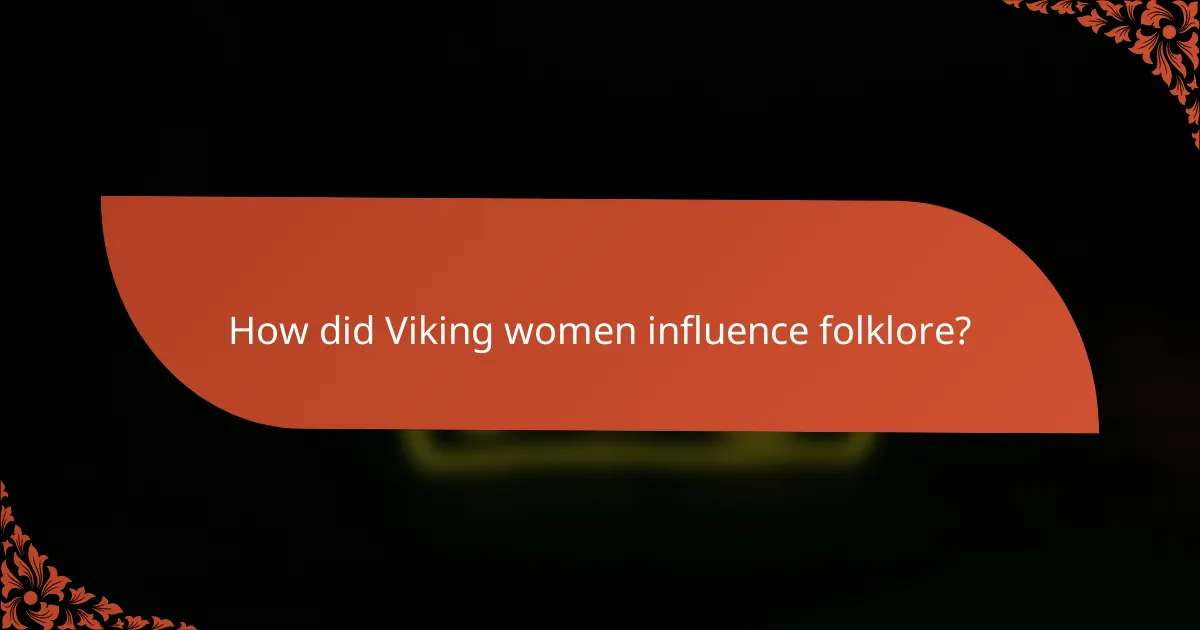
How did Viking women influence folklore?
Viking women played a crucial role in shaping folklore by serving as storytellers and symbols of fertility. Their contributions helped preserve cultural narratives and traditions that were vital to Viking society.
Storytellers preserving history
Women in Viking culture were often the primary storytellers, passing down tales of gods, heroes, and everyday life. Through oral traditions, they kept history alive, ensuring that the experiences and lessons of past generations were not forgotten.
These stories were typically shared during gatherings, where women would recount events and legends, weaving in moral lessons and cultural values. This practice not only entertained but also educated the community, reinforcing shared beliefs and identity.
Women as symbols of fertility
In Viking folklore, women were frequently depicted as symbols of fertility and abundance, representing the earth’s nurturing qualities. This association made them central figures in agricultural rituals and seasonal celebrations, where their roles were vital for ensuring bountiful harvests.
Goddesses like Freyja embodied these qualities, highlighting the reverence for women as life-givers. Such representations in folklore reinforced the importance of women in both family and societal structures, linking them to prosperity and continuity.
Role in family and community narratives
Women were integral to family and community narratives, often serving as the backbone of social structures. Their experiences and perspectives shaped the stories told within households, influencing how values and traditions were transmitted across generations.
In many tales, women were portrayed as wise figures, providing guidance and support to their families. This portrayal not only emphasized their importance in domestic life but also highlighted their influence in broader community dynamics, fostering unity and resilience among the people.
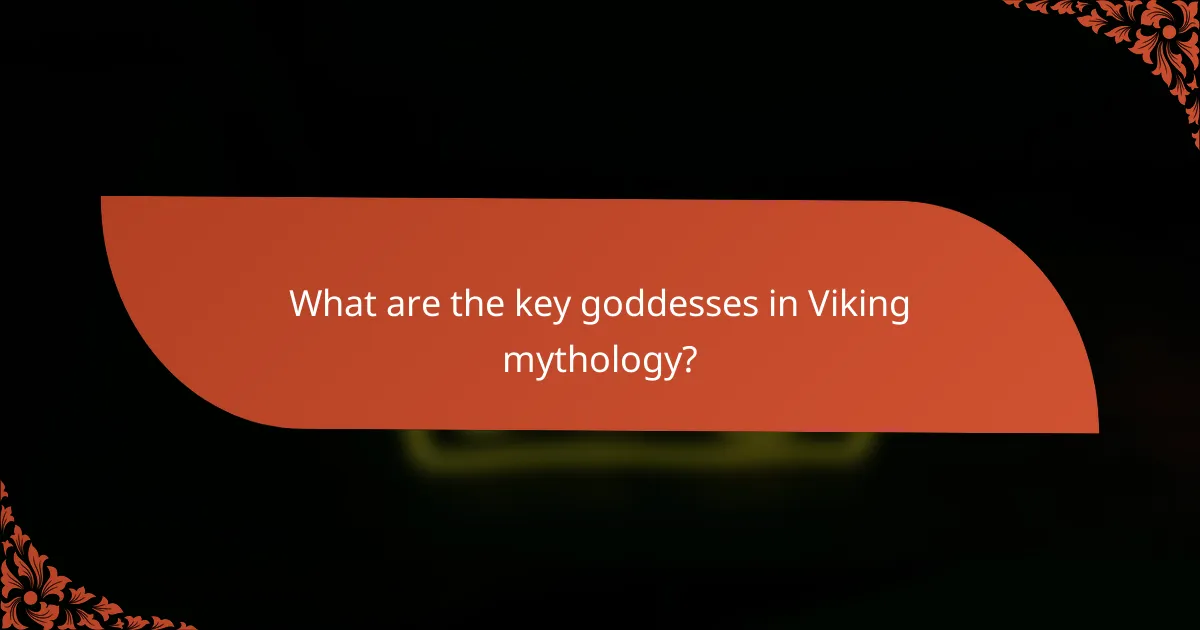
What are the key goddesses in Viking mythology?
The key goddesses in Viking mythology include Freyja, Frigg, and Skadi, each embodying unique attributes and roles within the Norse pantheon. These goddesses were central to various aspects of life, including love, war, and the natural world, influencing both mythology and the daily lives of the Vikings.
Freyja and her attributes
Freyja is one of the most prominent goddesses in Norse mythology, associated with love, beauty, fertility, and war. She is often depicted as a powerful figure who rides a chariot pulled by two cats and possesses a magical necklace known as Brísingamen, symbolizing her allure and strength.
In addition to her roles in love and fertility, Freyja is also a goddess of war. She selects half of the warriors slain in battle to reside in her hall, Fólkvangr, while the other half go to Valhalla, emphasizing her dual nature as both a nurturing and fierce deity.
Frigg’s significance
Frigg, the wife of Odin, is revered as the goddess of marriage and motherhood. She is known for her wisdom and foresight, often associated with domestic life and the protection of families. Frigg’s ability to see the future, though she cannot change it, highlights her role as a guardian of fate.
Her significance extends to the realm of prophecy and knowledge, making her a vital figure in the Norse belief system. Frigg’s influence is evident in various myths, where her decisions and insights often shape the outcomes of events, showcasing her integral role in the pantheon.
Skadi and her role
Skadi is a goddess associated with winter, hunting, and the mountains, representing the harshness and beauty of nature. She is often depicted as a skilled huntress, wielding a bow and arrows, and is known for her independence and strength, having chosen her own husband from among the gods.
Her story emphasizes themes of choice and resilience, as she sought vengeance for her father’s death but ultimately found a new life among the gods. Skadi’s connection to the natural world makes her a significant figure for those who relied on hunting and the wilderness for survival in Viking society.

How did Viking culture view female power?
Viking culture recognized female power in various aspects of society, allowing women to hold significant roles both in the household and in broader community affairs. Women were not merely passive figures; they could own property, manage businesses, and even influence political decisions.
Legal rights of women
Viking women enjoyed a range of legal rights that distinguished them from many other cultures of the time. They could inherit property, initiate divorce, and retain ownership of their dowries, which provided them with a degree of financial independence. This legal status allowed women to play active roles in economic matters, often managing farms and businesses.
In some cases, women could represent themselves in legal disputes, showcasing their rights to participate in the legal system. This empowerment was crucial in a society where men often traveled for trade or warfare, leaving women to manage affairs at home.
Women in leadership roles
Women in Viking society could ascend to leadership roles, particularly in the absence of male relatives. Some women, known as “shieldmaidens,” were believed to have fought alongside men in battle, although historical evidence of this is mixed. More commonly, women served as heads of households, making decisions about land and resources.
Additionally, women could hold positions of influence within their communities, acting as mediators or leaders in local gatherings. Their roles often extended to spiritual leadership, where women participated in rituals and maintained cultural traditions, further solidifying their importance in Viking society.

What are the connections between Viking women and modern interpretations?
Viking women are often portrayed in modern interpretations as strong, independent figures, reflecting contemporary values of gender equality. This shift highlights their roles in society, from warriors to leaders, reshaping our understanding of their contributions in Viking culture.
Influence on contemporary literature
Modern literature frequently draws inspiration from Viking women, portraying them as complex characters who challenge traditional gender roles. Authors like Neil Gaiman and Margaret Atwood incorporate these figures into their narratives, emphasizing themes of empowerment and resilience.
Books such as “The Half-Drowned King” by Linnea Hartsuyker explore the lives of Viking women, showcasing their influence on family and society. These stories often blend historical accuracy with imaginative elements, allowing readers to connect with the past in a meaningful way.
Representation in film and media
Films and television series have increasingly featured Viking women as central characters, reflecting their importance in Norse mythology. Productions like “Vikings” and “The Last Kingdom” depict female warriors and leaders, challenging stereotypes and highlighting their strategic roles in battles.
Media representations often emphasize the duality of Viking women’s lives, showcasing both their domestic responsibilities and their prowess in combat. This balanced portrayal helps to create a more nuanced understanding of their contributions to Viking society and culture.
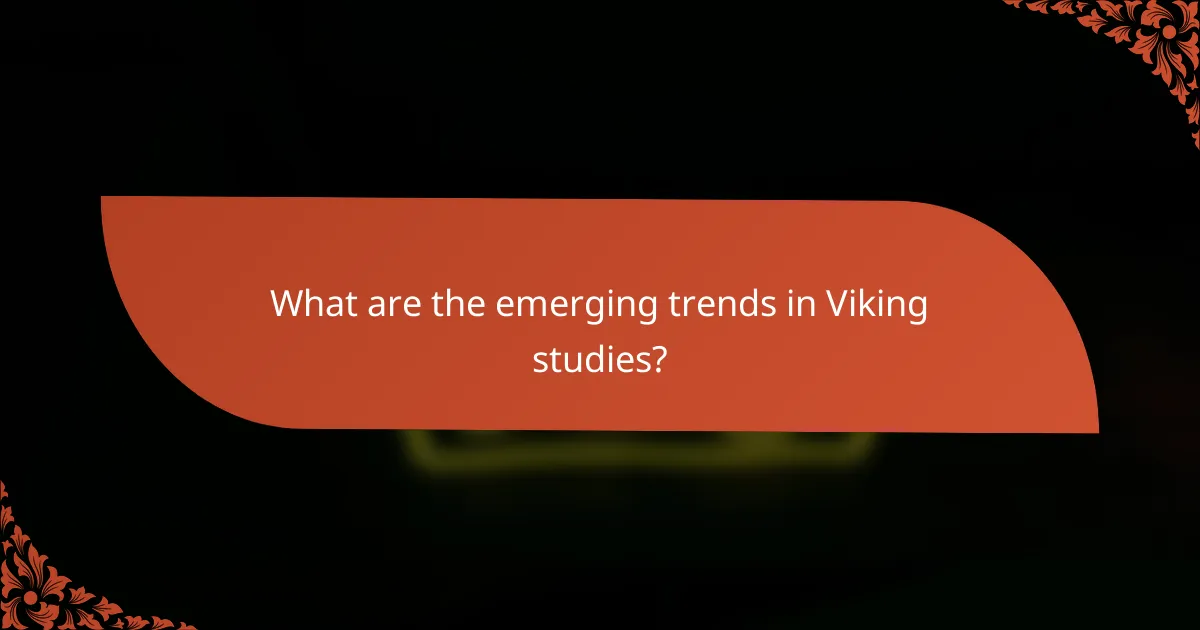
What are the emerging trends in Viking studies?
Emerging trends in Viking studies focus on interdisciplinary approaches, integrating archaeology, history, and gender studies to gain a more nuanced understanding of Viking society. Recent research emphasizes the roles of women and the reinterpretation of historical narratives, highlighting the complexity of Viking culture.
New archaeological findings
Recent archaeological discoveries have significantly advanced our understanding of Viking life, particularly regarding women’s roles. Excavations of burial sites have revealed the presence of female warriors, challenging traditional views that predominantly associate combat with men. These findings suggest that women may have held more diverse and influential positions in Viking society than previously thought.
Additionally, artifacts such as tools, jewelry, and domestic items found in women’s graves indicate their involvement in both household management and economic activities. This evidence points to a more active participation of women in various aspects of Viking life, from trade to warfare.
Reinterpretation of historical texts
Scholars are increasingly reexamining historical texts, such as the sagas and Eddas, to uncover the roles of women in Viking culture. These texts, often written by men, have historically downplayed female contributions. By applying feminist literary analysis, researchers are revealing the complexities of female characters and their significant roles in shaping societal norms and values.
This reinterpretation highlights how women were not merely passive figures but rather influential agents within their communities. It encourages a broader understanding of gender dynamics in Viking society, emphasizing the need to view historical narratives through a more inclusive lens.
Impact of feminism on Viking studies
The rise of feminist perspectives in Viking studies has transformed the field, prompting scholars to challenge long-held assumptions about gender roles. Feminist theory encourages a critical examination of sources and promotes the inclusion of women’s experiences and contributions in historical narratives. This shift has led to a more balanced portrayal of Viking society.
Moreover, feminist scholarship has inspired new research questions and methodologies, fostering a collaborative environment among historians, archaeologists, and gender studies experts. As a result, the study of Viking culture is becoming increasingly rich and multidimensional, reflecting a more accurate representation of its diverse population.





